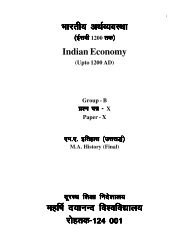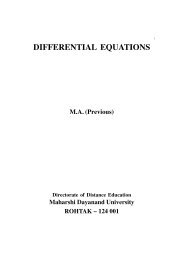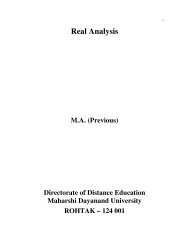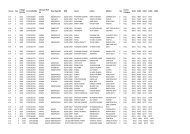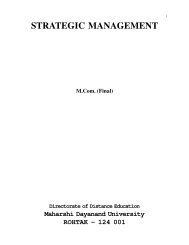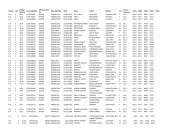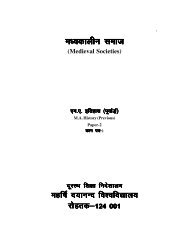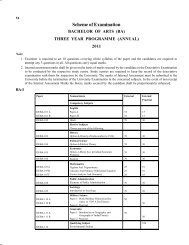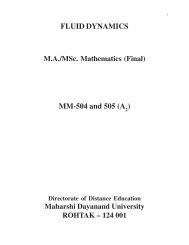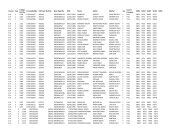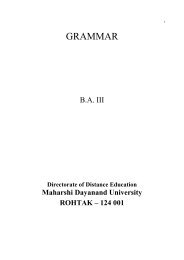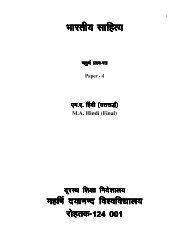Advanced Abstract Algebra - Maharshi Dayanand University, Rohtak
Advanced Abstract Algebra - Maharshi Dayanand University, Rohtak
Advanced Abstract Algebra - Maharshi Dayanand University, Rohtak
You also want an ePaper? Increase the reach of your titles
YUMPU automatically turns print PDFs into web optimized ePapers that Google loves.
UNIT-IV 81<br />
Definition. Let S be a subring of a ring R. If<br />
x ∈ S, a ∈ R ax ∈ S ,<br />
then S is called left ideal of R.<br />
If x ∈ S , a ∈ R xa ∈ S ,<br />
then S is called right ideal of R.<br />
Ideals and Quotient Rings<br />
If x ∈ S, a ∈ R xa ∈ S and ax ∈ S then S is called two sided ideal or simply ideal of R.<br />
* If R is a commutative ring then all the three notions are same since in that case ax = xa ∈ S .<br />
** Every ring has two trivial ideals :<br />
(i) R itself and is called unit ideal.<br />
(ii) Zero ideal [0] consisting of zero element only.<br />
Any other ideal except these two trivial ideals is called proper ideal.<br />
Theorem.<br />
The intersection of any two left ideals of a ring is again a left ideal of the ring.<br />
Proof. Let S 1 and S 2 be two ideals of R. S 1 and S 2 being subring of R, S 1 ∩ S 2 is also a subring of R.<br />
Again let x ∈ S 1 ∩ S 2 .<br />
Let a ∈ R.<br />
x ∈ S 1 , x∈ S 2 .<br />
Then since S 1 and S 2 are left ideals,<br />
a ∈ R, x ∈ S 1 ax ∈ S 1<br />
a ∈ R , x ∈ S 2 ax ∈ S 2<br />
ax ∈ S 1 ∩ S 2<br />
S 1 ∩ S 2 is a left ideal.<br />
Theorem :- Let K(T) be the kernel of a ring homomorphism T : R → S . Then K(T) is a two sided<br />
ideal of R.<br />
Proof. Let a, b ∈ K (T). Then<br />
T(a) = T(b) = 0 .<br />
Therefore,<br />
T(a+b) = T(a) + T(b) = 0 + 0 = 0 (by ring<br />
T(ab) = T(a).T(b) = 0.0 = 0 homomorphism)<br />
which implies that a+b, ab ∈ K(T). Hence K(T) is a subring of R.<br />
Now let a ∈ K(T) and r ∈ R . It suffices to prove that ar, ra ∈ K(T)<br />
T(ar) = T(a).T(r)<br />
= 0 . T(r) (Θ a ∈ K(T) T(a) = 0)<br />
= 0<br />
This implies that ar ∈ K(T). Similarly,<br />
T(ra) = T(r) T(a) = T(r).0 = 0<br />
Hence K(T) is an ideal of R.<br />
Theorem. A field has no proper ideal.<br />
ra ∈ K(T) .



